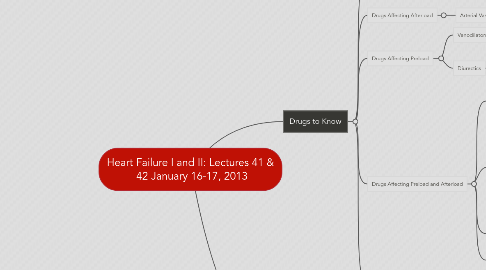
1. Drugs to Know
1.1. Inotropic Drugs- help heart beat more forcefully
1.1.1. Digitalis glycosides- alter contractility
1.1.1.1. Drugs
1.1.1.1.1. Digoxin
1.1.1.1.2. Digitoxin
1.1.1.2. MOA: 1. increase intracellular Ca2+ concentration (cardiac muscle), 2. Direct increase in vagal tone, 3. Reduce Sodium reabsorption in kidney
1.1.1.3. Effects: increased Co, Decreased Sympathetic activity, increase diuresis, lower blood volume/edema, increased contractility
1.1.2. Sympathomimetic Amines
1.1.2.1. Norepinephrine Isoproternol Dopamine Dobutamine
1.1.2.1.1. MOA: acts at adrenergic receptors, improves cardiac contractility and relaxation
1.1.3. Phosphodiesterase Inhibitors
1.1.3.1. Inamrinone
1.1.3.1.1. MOA:inhibit phosphodiesterase type 3, increases cAMP production, increases contractility in venous and arterial circulation
1.1.3.2. Milrinone
1.1.3.2.1. MOA:inhibit phosphodiesterase type 3, increases cAMP production, increases contractility in venous and arterial circulation
1.2. Drugs Affecting Afterload
1.2.1. Arterial Vasodilators
1.2.1.1. Hydralazine
1.2.1.1.1. MOA: Relaxes arterioles (not viens) independent of sympathetic interactions. Decrease Blood Pressure- leads to reflex tachy. which increases cardiac output. Directly increases renal blood flow.
1.2.1.1.2. Clinical Use: Treat HTN also good for PREGNANT women w/ HTN
1.2.1.1.3. Special Info: Give with betablockers and diuretics. Patients with ischemic heart disease.
1.2.1.1.4. Side Effects: Reflex tachycardia, Lupus syndrome, peripheral neuritis (inteferes with Vitamin B6 metabolism in neural tissue.)
1.3. Drugs Affecting Preload
1.3.1. Venodilators
1.3.1.1. Nitroglycerin
1.3.1.1.1. Special Info: Reduces preload by reducing venous tone. This allows blood pooling in the periphery. Take sublingually; last 2-12hrs
1.3.1.1.2. MOA: Dilates large myocardial arteries to increase blood supply to the heart.
1.3.1.1.3. Clincial Use: Angina (all forms). May be used prior to exercise to prevent angina (the sole function of Isosorbide dinitrate)
1.3.1.1.4. Side Effects: Hypotension, Rebound tachycardia, bradycardia, cerebral ischemia, contact dermatitis
1.3.1.2. Isosorbide dinitrate
1.3.1.2.1. MOA: Dilates large myocardial arteries to increase blood supply to the heart (NOT ACUTELY)
1.3.1.2.2. Clinical Use: Prophylaxis of Angina. Not for acute attack
1.3.1.2.3. Special Info: only last about 1-4 hrs
1.3.1.2.4. Side Effects: Hypotension, Rebound tachycardia, bradycardia, cerebral ischemia, contact dermatitis
1.3.2. Diurectics
1.3.2.1. Loop Diurectics- made from sulfa just like sulfonamide antibiotics (otoxicity)
1.3.2.1.1. Bumetanide (MOST POTENT)
1.3.2.1.2. Furosemide (LASIX)
1.3.2.2. Thiazide Diurectics
1.3.2.2.1. hydrochlorothiazide
1.4. Drugs Affecting Preload and Afterload
1.4.1. Nitrates
1.4.1.1. Nitroprusside
1.4.1.1.1. MOA: Converted to nitric oxide which induces cGMP. Relaxes smooth muscle by dephosphorylating myosin.
1.4.1.1.2. Clinical Use: I.V. used in Hypertensive Crisis
1.4.1.1.3. Special Info: Dramatic changes in blood pressure occur with small infusion rate changes
1.4.1.1.4. Side Effect: Severe Hypotension, cyanide toxicity, hepatotoxicity
1.4.2. Alpha Adrenergic blockers
1.4.2.1. Prazosin
1.4.2.1.1. MOA: Peripheral alpha 1 adrenergic antagonist. Dilates both arteries and veins.
1.4.2.1.2. Clinical Use: HTN, and HTN w/ CHF
1.4.2.1.3. Special Info: Phenobarbital shorts its half-life, the severe orthostatic hypotension patients should be lying down and observed for 2hrs after initial doses
1.4.2.1.4. Side Effects: Hypotension (postural), sodium depletion, Edema
1.4.3. Angiotensin Converting Enzyme (ACE) Inhibitors
1.4.3.1. Captopril
1.4.3.1.1. MOA: inhibits the angiotensin converting enzyme (ACE), increases bradykinin by inhibiting kininase II
1.4.3.2. Enalapril
1.4.3.2.1. MOA: inhibits the angiotensin converting enzyme (ACE), increases bradykinin by inhibiting kininase II
1.4.3.3. Lisinopril
1.4.3.3.1. MOA: inhibits the angiotensin converting enzyme (ACE), increases bradykinin by inhibiting kininase II
1.4.4. Angiotensin II Receptor blockers (ARBs) - meds you switch to when ACE Inhibitors have patients COUGHING TOO MUCH!
1.4.4.1. Valsartan
1.4.4.1.1. MOA: binging membrane bound AT1 receptors that displace Ang II from binding.
1.4.4.2. Losartan
1.4.4.2.1. MOA: binging membrane bound AT1 receptors that displace Ang II from binding.
1.5. Others
1.5.1. Beta-adrenergic receptor blockers
1.5.1.1. the Beta-adrenergic receptor blockers are used for treatment of CHF because it mediates the adverse effects of the pathology.
1.5.1.1.1. Metoprolol CR/XL (controlled release, long acting) Beta1/Beta2 selectivity: 74 (Highly selective) Special Info: No affinity for alpha-adrenergic receptors.
1.5.1.1.2. Bisoprolol Beta1/Beta2 selectivity: 120 (Highly selective) Special Info: No affinity for alpha-adrenergic receptors.
1.5.1.1.3. Carvedilol Beta1/Beta2 selectivity: 7.3 (minimally beta-1 selective) Special Info: Additional high-affinity alpha1-receptor blocking potency (vasodilation).
1.5.2. Aldosterone blockers
1.5.2.1. Aldosterone Receptor Antagonists
1.5.2.1.1. MOA:Not completely understood, but it prevents cardiac fibrosis and prevents depletion of K+ serum levels which has antiarr. properties. Clinical Use: HTN 1. Spironolactone (side effects: hyperkalemia, gynecomastia, impotence, menstrual irregularities) 2. Eplerenone (side fffects: hyperkalemia, less or no endocrine-related side-effects, alternative to spironolactone)
